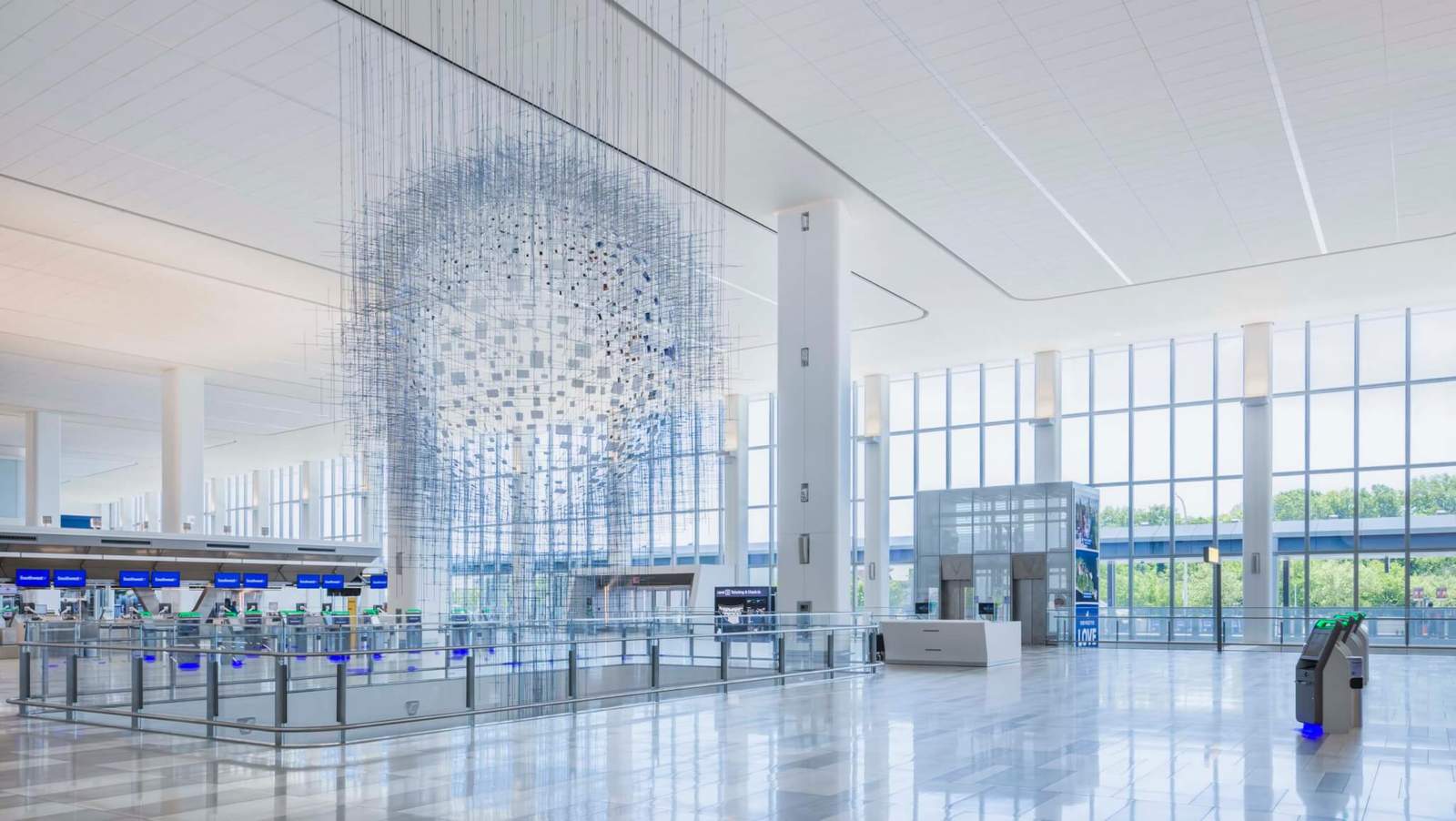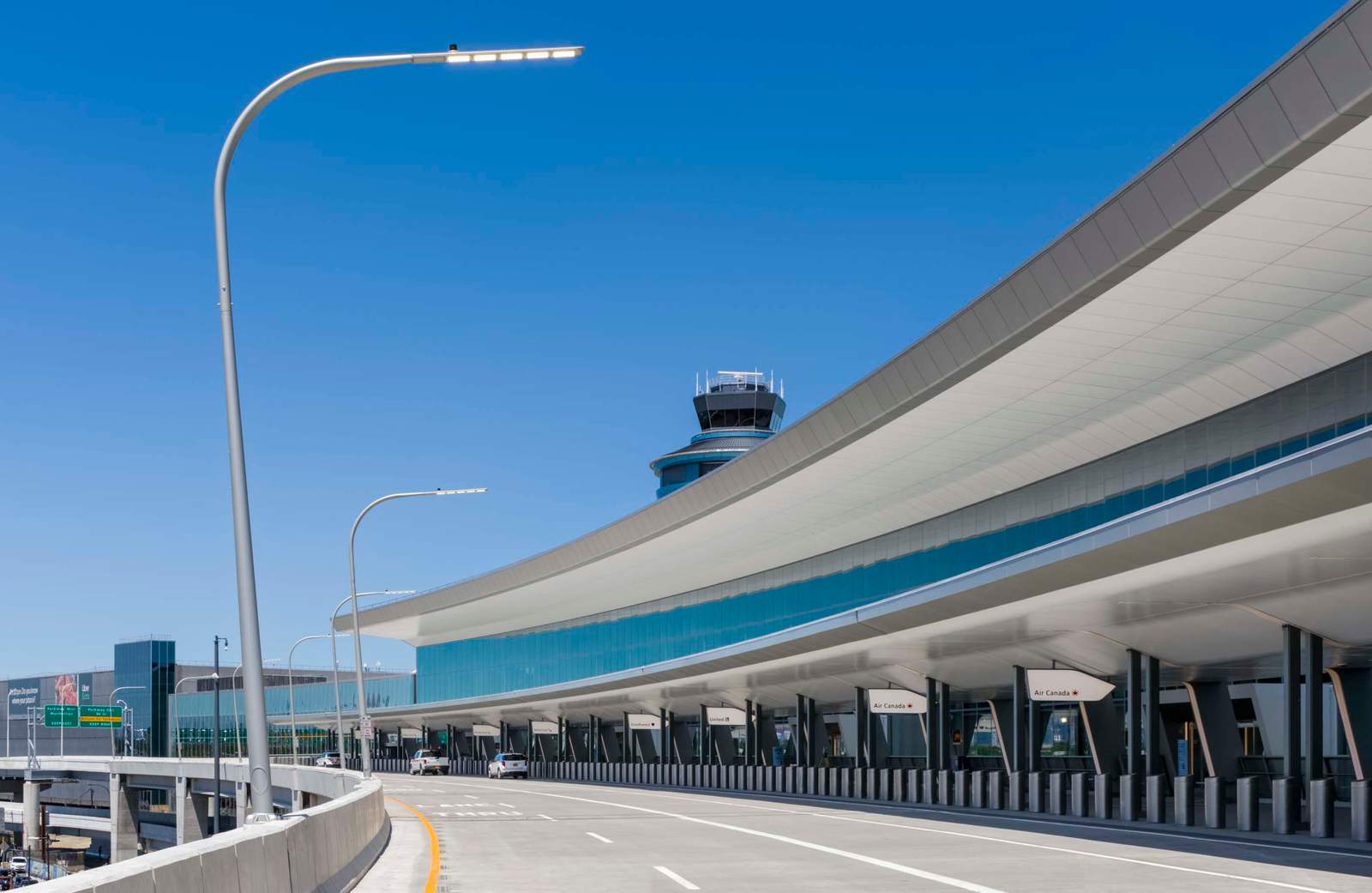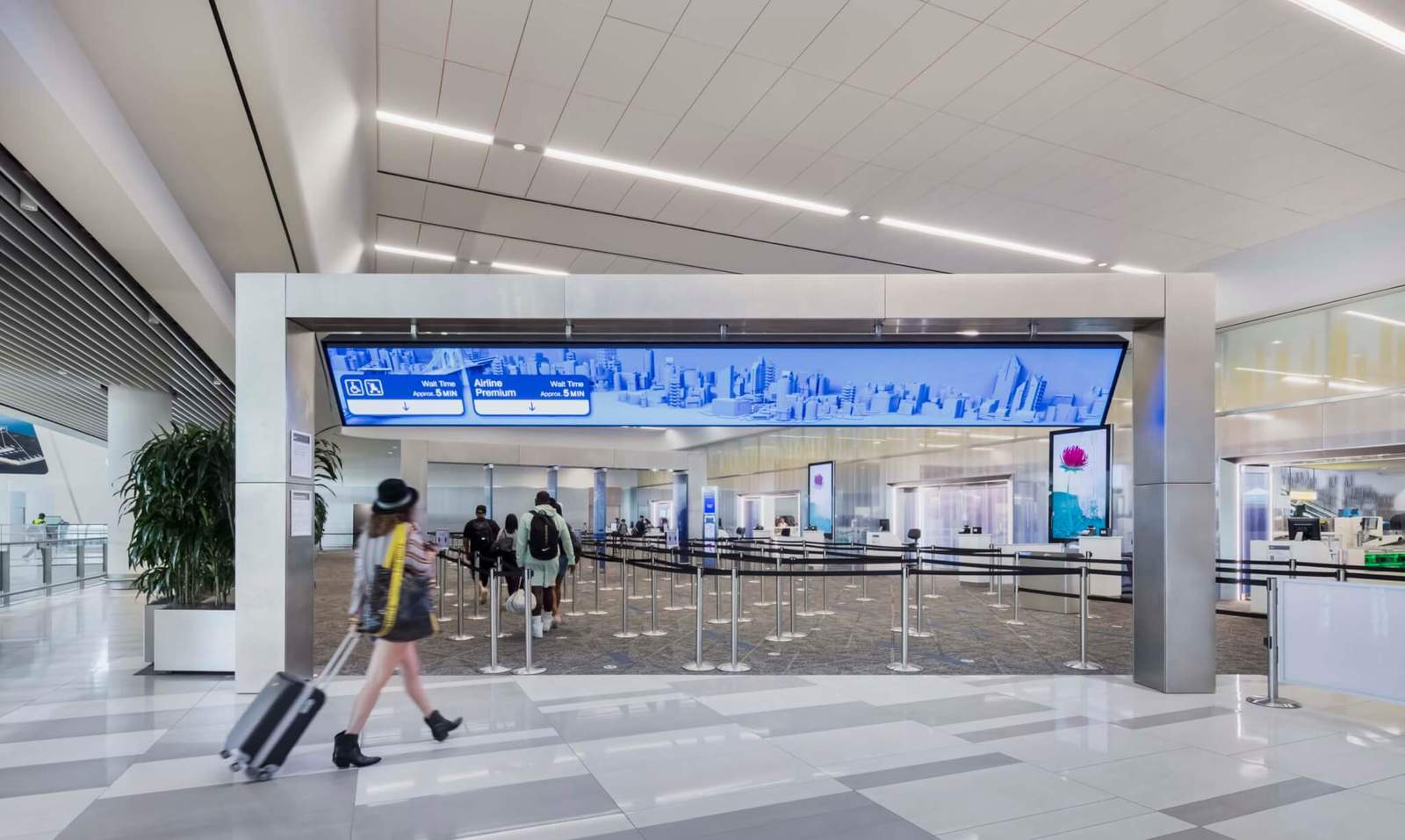After stepping foot in the new Terminal B at LaGuardia Airport, New Yorkers pass through an airy ticketing hall and security checkpoint, ascend via escalator, trek through a maze of Duty Free shops, then across a food court, then over a skybridge with more bars and restaurants, and then down another set of escalators to a terminal level lined with even more shops before finally arriving at their gate. Effectively, it’s an airport, just like nearly anywhere else in the world. Or, as Justin Davidson wrote when the facility opened early last year, it’s “no longer a hellscape.”
LaGuardia’s newly widened halls and expanded bathrooms are a welcome relief for the 30-some million passengers that use the airport annually. But as we New Yorkers collectively heal from our traumatic memories of the old Terminal B, we should acknowledge that the new terminal is a mostly average building fitted with a few off-the-shelf tricks to distract us from mediocrity. The food court is a row of gray-paneled miniature buildings housing uncanny facsimiles of “New York” amenities. (On a recent trip, I paid $13 for a slice of cheesecake and a coffee from Junior’s, just down the hall from the Brooklyn Diner.) An LED-lit dancing fountain anchors a cacophony of seating, shops, circulation, and playground equipment; an amenity which visually recalls both the bland-tech-dad-tchotchke-ism of an inflight Brookstone catalogue as well as the impromptu waterfalls that erupt onto subway platforms just about whenever it rains. Gazing upward, the ceiling above is a sea of gray, drop-ceiling paneling. Bafflingly, much of the food court is built directly against a massive, curved curtain wall, negating the views and sunlight this expensive feat of engineering offers. Though schlocky, my favorite details are in the bathrooms, where paper-towel dispensers are mysteriously hidden inside cheap painted cabinetry liable to break soon, and the urinals are uplit by a moody, acrylic light shelf which seems about three months out from becoming hopelessly dirty.

Still, the banalities of this reworked complex pale in comparison to the overall trajectory of its realization. Though incremental upgrades to the airport had been discussed for decades prior, the story began in earnest almost nine years ago. As part of routine duties as Vice President, in February 2014 Joe Biden visited Philadelphia to have his picture taken by local media while sitting at the controls of a new electric Amtrak locomotive. Biden was stumping for expanded infrastructure spending, a cornerstone of then-President Obama’s policy ambitions, which faced heavy resistance in Congress. Biden riffed: “If I blindfolded someone and took him at 2 o’clock in the morning into the airport in Hong Kong and said, ‘Where do you think you are?’ He’d say ‘This must be America, it’s a modern airport.’ If I took him blindfolded and took him to LaGuardia Airport in New York, he must think, ‘I must be in some Third World country.’” “I’m not joking,” he concluded. With this confusing, problematic, and jingoistic joke, Biden unwittingly mobilized political forces to procure billions of dollars in financing to renovate LaGuardia Airport—and architects would play little part in the final outcome.
Andrew Cuomo, then in his third year as governor of New York, acted quickly to leverage momentum from Biden’s gaffe. Where just a month earlier he had berated a $2.4 billion renovation plan drawn up by the Port Authority for being insufficient and “frozen in time,” in October Cuomo held a joint press conference with Biden to introduce a master plan design competition for an $8 billion project. In May 2015, Cuomo announced that New York state government would assume control of the project and, without formally revealing the results of the design competition, announced that HOK, teamed with Skanska, was engaged to merge the three best schemes—by SHoP, Dattner Architects, and Present Architecture—into one.


These competition entries would only later reveal themselves in individual press releases. In many ways, the mandate for the new LaGuardia was clear: The entire infrastructure of the airport, from the buildings to the transportation networks to the taxiways, was obsolete and over capacity. The heavily trafficked Terminal B mixed waiting areas, shopping, restaurants, and bathrooms into a single narrow corridor that produced a chaotic pedestrian space only Jane Jacobs could love.
While Present Architecture pitched a trio of starfish-like terminals, SHoP and Dattner Architects proposed roughly similar schemes that made the common-sense infrastructural upgrades recommended in the project brief. Both terminal schemes branched from a long, continuous volume massed as closely against the Brooklyn-Queens Expressway as possible. This megastructure vertically organized the processing functions of the airport, starting with passenger drop-off via taxi, bus, rental car, train, or ferry through ticketing, luggage sorting, and security.

The proposals by SHoP and Dattner made vague references to transit systems that do not exist. SHoP’s proposal showed a platform generically marked “Express Train” which connected to a new ferry terminal inconveniently located on the wrong side of the airport for commuters from Manhattan in Flushing Bay. Dattner’s plan depicts two new AirTrain lines extending from the airport to Sunnyside and Jamaica as well as the long-wished-for extension of the R train from Astoria. In another city, these basic recommendations would be easily implemented into a final scheme: Both of Chicago’s major airport terminals are connected directly to the subway system, Detroit opened a heavy-rail commuter system between downtown and its airport in 2016, and Washington, D.C., completed an extension of the Metro to Dulles late last year. Even air travelers arriving at Cleveland Hopkins International Airport in Ohio can hop on a one-seat light-rail ride to downtown Believeland.
Cuomo, in the meantime, engineered a compliant Port Authority. In the wake of the “Bridgegate” scandal, former New Jersey governor Chris Christie abdicated much of his share of Port Authority responsibilities, leaving a power vacuum for Cuomo to unilaterally appoint and remove Port Authority commissioners and install an inspector general, a new position he invented. HOK’s frankensteined proposal materialized, fully developed and shovel-ready, in a July 2015 public unveiling and would begin construction just 8 months later. This proposal discarded the architectural drama of SHoP’s proposal along with all of the transportation recommendations of Dattner’s save for one: an $8 AirTrain ride to the terminus of the 7 Train in Flushing, Queens.

Years later, the improved Terminal B—itself a $4 billion project, one of the largest public-private partnerships in the country and in American aviation history—can be considered a win mostly because passengers now have enough room to comfortably walk around. Within its own campus, the new LaGuardia optimizes the flows of aircraft, passengers, luggage, and service work, an impressive effort of choreography. But for broader connectivity, the new airport inherits all of the same regional crises extant in the old one. As one of the lowest areas of the city, LaGuardia is prone to short-term flooding like Newark Airport faced in September 2021 as well as the longer-term effects of sea-level rise. The terminals are still not connected to any rail or ferry service, and even the badly designed Airtrain to Flushing has been postponed after costs came in over $2 billion. Meanwhile, the private entities that helped assemble financing to renovate the airport stand to turn a profit, as LaGuardia Gateway Partners holds a 35-year lease to manage the facility.

The Port Authority’s unique political structure, free from democratic oversight and many public review processes, positions it as a rare public agency capable of building at a large scale in New York today. It rewards politicians who embark on building projects with more power while disincentivizing collaboration with other public agencies, such as the MTA, where new projects have been stalled for decades.
This new LaGuardia, like many of Cuomo’s infrastructural projects, is a costly commitment to the status quo. Of the proposals available for public review, only ReThink NYC’s proposal challenged the competition brief. In that scheme, Rikers Island would be demolished to expand runway and taxi space as well as offer new land to connect the airport to existing rail networks in Queens and the South Bronx, creating a new major transportation hub for Long Island, Westchester, and Connecticut and alleviating stress on Penn and Grand Central Stations. Most importantly, this proposal would have forced the closure of Rikers Island, an ongoing humanitarian embarrassment, two years before former mayor Bill de Blasio would promise to do so. While it still hasn’t closed, the future of Rikers remains a subject of debate: A recent scheme from the Regional Plan Association and RISD imagined it as a green energy hub.
For architects, there is an important lesson to remember that even in their lust to kneel to power, each of SHoP’s, Dattner’s, and Present Architecture’s short-listed proposals were replaced with HOK’s shovel-ready mash-up. The flashy renderings generated for their plans were brandished by the governor to engineer public support for an even-more-generic pork project finalized without their involvement. Architects must offer not only their technical expertise but also their imaginations to challenge assumptions of what we are entitled to as citizens and the demands we must make to build the kind of world we wish to live in.


In late 2022, Governor Kathy Hochul appeared at John F. Kennedy International Airport on the occasion of the groundbreaking for a new $9.5 billion terminal, the first phase of a reconstruction that’s larger than LaGuardia’s improvement. As this new investment frenzy unfolds with little public resistance, it’s useful to compare this activity to the decay spiral faced by the New York City Housing Authority’s 335 housing projects after decades of deferred maintenance. The policy responses to that crisis are a lethal mix of austerity budgeting and property liquidation that threaten to displace hundreds of thousands of New York’s poorest citizens as the properties where they live are placed under private control. It leads one to wonder: If Joe Biden had made a joke in 2014 about public housing, would we have witnessed the same results?


 العربية
العربية